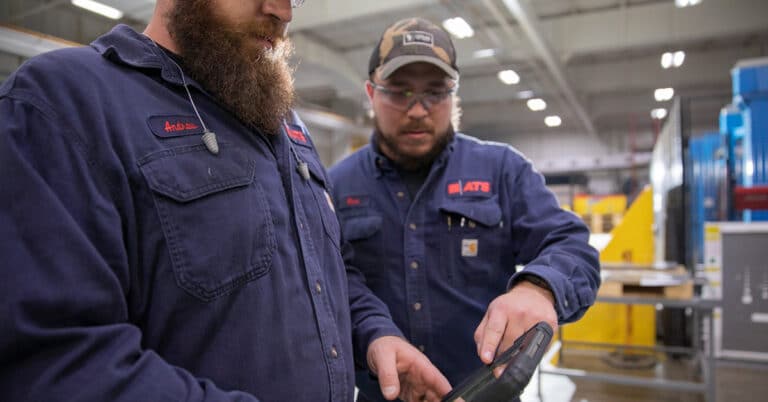How do you know if you’re getting value-for-money from maintenance? It’s impossible to tell without objective measures, but some measures are more useful and important than others. The key is to link them to business goals. That quantifies maintenance effectiveness, and perhaps of greater importance, it drives behaviors that lead to increased success.
This blog is about ways of measuring maintenance performance. After clarifying the relationship between KPIs and metrics, it reviews the four categories, discusses which are most important and offers some guidance on using them.
What are industrial maintenance KPIs?
Maintenance Key Performance Indicators (KPIs) are metrics that link to business goals, which is what distinguishes them from other metrics. The difference is subtle but important.
A metric is a measurement. Monthly maintenance spend is an example. It gives managers a view into an aspect of the maintenance function, but it may or may not link to a business goal. If there is a goal to cut costs by x% over the prior year, the metric becomes a KPI.
In manufacturing, KPIs often relate to output. Maintenance affects output because unreliable machines create unplanned downtime and lost production. (They can also cause safety and quality problems.) Many businesses use Overall Equipment Effectiveness (OEE) as a KPI, and the maintenance function will measure activities, (use metrics), that contribute to this goal.
Key categories of industrial maintenance KPIs
Widely used industrial maintenance KPIs that link to business goals fall into four groups:
- Operational
- Financial
- Efficiency
- Safety and compliance
Operational KPIs are those relating to the availability of production equipment. They link to output goals, and include uptime, downtime, OEE and Mean Time Between Failure (MTBF).
Financial KPIs tie into cost management, ROI and profitability targets. They include maintenance cost per unit, return on investment (ROI) for maintenance activities and budget adherence.
Efficiency KPIs relate to how well maintenance function resources are utilized in pursuit of business goals like availability and output. These include maintenance backlog, work order completion rate and Mean Time To Repair (MTTR).
Safety and compliance KPIs such as Days Since Last Reportable Accident may not have an obvious connection to maintenance, but the linkage is strong. Unreliable equipment is often a major cause of accidents, and many items of equipment subject to regulatory scrutiny — such as emission controls and waste handling — come under the purview of maintenance.
Essential KPIs for industrial maintenance
Five KPIs stand out for their ability to drive increased uptime, availability and maintenance effectiveness:
- OEE
- Maintenance cost per unit of production
- Work order backlog
- Preventive maintenance compliance
- MTBF
Perhaps the most important KPI for maintenance process improvement, OEE measures the effectiveness with which manufacturing assets are being used. The top-level number produced by calculating OEE is useful for benchmarking and improvement measurement, but the real benefit comes from looking into its three components: availability, performance and quality.
Maintenance is driven by how intensively production assets are used, so expenditure is not a particularly helpful metric. (Add additional shifts and maintenance costs will rise in concert.) Maintenance cost per unit of production is a better KPI for understanding the cost efficiency of maintenance efforts relative to output.
A backlog KPI shows how well the maintenance function is keeping pace with demand. A rising backlog implies insufficient resources and/or an increasing rate of breakdowns (which will show up in other metrics). Backlog is useful for both assessing whether the function has the resources it needs as well as whether the right preventive maintenance (PM) work is being done.
Related to backlog, PM compliance measures the percentage of scheduled preventive maintenance tasks completed on time. (“On time” is often defined as within a certain window.) If PM isn’t being done when scheduled, the frequency of machine breakdowns will rise, (and if it doesn’t, the implication is that either too much PM or the wrong PM was being done).
MTBF for a machine or piece of equipment is calculated as: (total hours) / (number of breakdowns in that period). It’s inversely proportional to reliability and is important for determining whether critical items of equipment need additional PM.
How to choose the right KPIs
A computerized maintenance management system, (CMMS), which is essential for delivering efficient and effective maintenance services, can generate large quantities of maintenance-related data. While this is valuable for optimizing aspects of asset care like preventive maintenance services, not all data needs to become a KPI.
Effective operational control flows from having the right KPIs rather than a large number. Three tips for selecting the right KPIs are:
1. Align KPIs with business goals: Maintenance KPIs should support what the business is trying to achieve. Plans for growth will put an emphasis on asset availability and uptime, while margin improvement targets will bring cost management and efficiency KPIs to the forefront.
2. Tailor KPIs for industry-specific needs: Process industries with tightly integrated equipment may need a greater focus on reliability than manufacturers in batch production who have alternative manufacturing routes if needed. Some industries may put more emphasis on safety in manufacturing than others, due to the materials or processes they use.
3. Use data wisely: Inaccurate data is worse than no data as it can send you in the wrong direction. Wherever possible, automate data collection and storage to increase accuracy. Use CMMS analysis capabilities to ensure consistency and to reduce the work involved in deriving actionable insights from KPIs.
Best practices for monitoring and improving KPIs
KPIs should not be static. Leaders should be prepared to make changes as needed. For example, when first implemented, experience may reveal them to be less useful than was expected. Likewise, business needs and goals can change quickly, requiring a change in KPIs. Important actions are:
- Review KPIs periodically: Determine if they continue to be relevant and effective and make changes as necessary. For example, address a goal of increasing availability by replacing a KPI for maintenance technician efficiency with one related to PM.
- Use technology for real-time tracking: IoT devices on equipment automate data collection and support predictive maintenance solutions. Use these to reduce the manual work needed and speed up KPI tracking and analysis.
- Benchmarking and continuous improvement: KPIs flow from business goals, but are those goals realistic? Will they put the business in a more competitive position? Comparing KPIs to industry standards and competitors will reveal the answers.
Use KPIs to improve asset care
The right KPIs ensure maintenance efforts link to business goals and give managers visibility into where actions are needed. The result is to drive increased equipment reliability and higher operational efficiency.
Take a look at the KPIs currently used in your maintenance work. Are they cost focused? Do they emphasize efficiency over effectiveness? What about a KPI for preventive maintenance? If nothing is in place, it’s likely effort is being expended in the wrong places.
The best practices discussed here have been shown to improve maintenance effectiveness. Need help improving your manufacturing maintenance effectiveness? Contact us for support.






